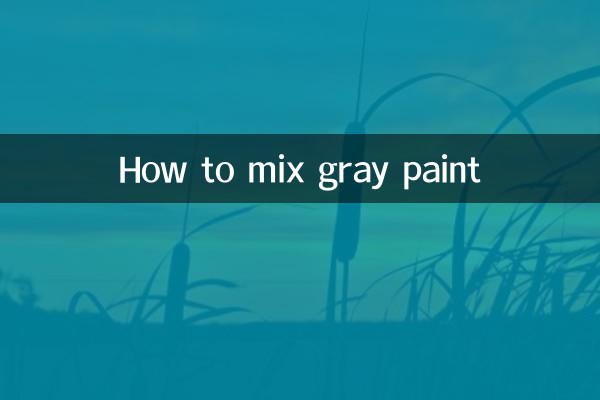How to mix gray paint
Among the hot topics in the past 10 days, home decoration and DIY paint color mixing have become the focus of discussion, especially the mixing method of gray paint has attracted much attention. As a neutral color, gray is widely used in modern home design, but how to mix the ideal gray paint confuses many people. This article will combine popular discussions on the Internet to provide you with a detailed analysis of gray paint mixing techniques and provide structured data reference.
1. Basic principles of gray paint mixing

Gray is a neutral color mixed with black and white, but in actual mixing, other colors often need to be added to adjust the warm and cold tendencies of the tone. Here is the basic formula for gray paint mixing:
| basic color | Scale range | Effect description |
|---|---|---|
| White | 60-90% | Determines the brightness of gray |
| black | 5-30% | Determine the shade of gray |
| blue/brown | 1-10% | Adjust warm and cool tones |
2. Popular gray formula reference
Based on recent social media discussions and expert advice, here are a few popular gray palettes:
| gray name | Recipe ratio | Applicable scenarios |
|---|---|---|
| warm gray | White 80%+black 15%+brown 5% | bedroom, living room |
| cool gray | White 85%+Black 10%+Blue 5% | modern style, office |
| neutral gray | White 75% + black 25% | Universal type |
3. Precautions for deployment
1.Small amount, many times principle: When adding black, be sure to add small amounts several times. Stir thoroughly after each addition and observe the color change.
2.light effect: The prepared colors should be observed under different lights. The color rendering effect under natural light and lighting may be different.
3.Color change after drying: After the paint dries, the color will darken by about 10-15%, so you need to leave room for this change when mixing.
4.Basal influence: Dark walls need to be painted with white primer first, otherwise the gray tone effect will be affected.
4. Recommended popular gray colors
According to recent hot discussions on the Internet, the following gray colors are the most popular:
| gray name | RGB value | heat index |
|---|---|---|
| High grade gray | 128,128,128 | ★★★★★ |
| silver gray | 192,192,192 | ★★★★☆ |
| graphite gray | 70,70,70 | ★★★★☆ |
| haze gray | 160,160,160 | ★★★☆☆ |
5. Recommended deployment tools
1.electronic scale: Accurately weigh the proportions of various paint colors, and the error is controlled within ±2g.
2.color palette: It is recommended to use a white palette for easy observation of the true color.
3.stir stick: Professional paint stirring stick ensures even color mixing.
4.color card: Ask for a color card before purchasing to compare the actual effect.
6. Frequently Asked Questions
Q: Why does the gray I mixed turn green?
A: It may be that the black pigment contains yellow components. It is recommended to change the brand or add a small amount of red to neutralize it.
Q: What’s the difference between testing a small area and painting a large area?
A: This is a normal phenomenon. It is recommended to apply 1 square meter to test the color first and observe it for 24 hours before making a decision.
Q: Can I use colored paint to adjust the gray color?
A: Yes, but you need to master the principle of complementary colors. For example, red + green + white can create a specific gray.
7. Summary
Mixing the ideal gray paint takes patience and practice. According to the recent hot discussion on the Internet, it is recommended to start with the basic formula and gradually adjust to a satisfactory color tone. Remember, gray is a versatile color, but different shades, brightness, and warm and cold tendencies will bring completely different visual effects. Hopefully the structured data and practical tips provided in this article will help you mix the perfect gray paint.

check the details

check the details